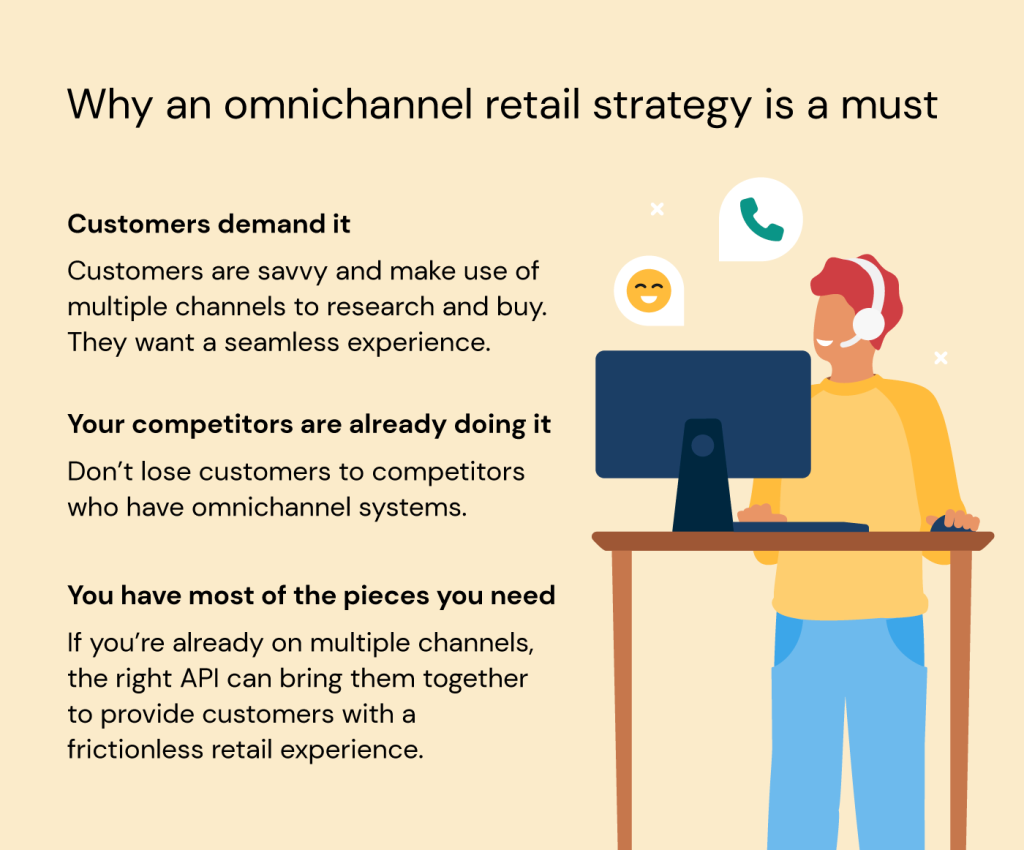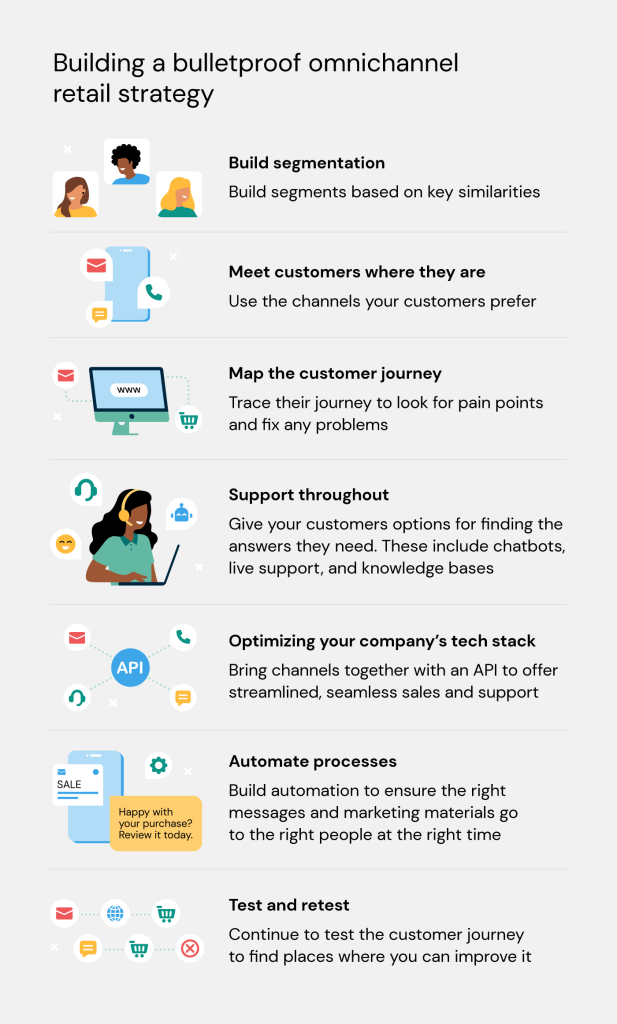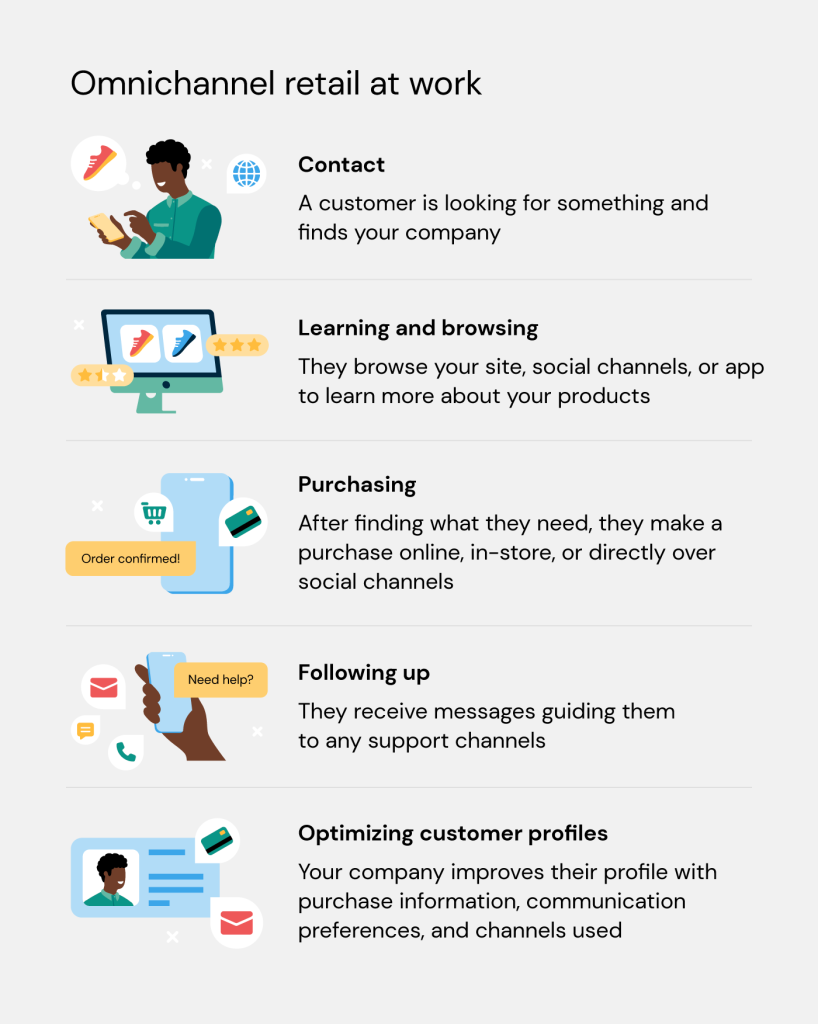Insights, Products
What is omnichannel retail? How to meet shoppers wherever they are

Insights, Products

Your retail customers are shopping on different channels. Browsing e-commerce sites, comparing prices on mobile apps, visiting brick-and-mortar stores, and engaging on social media – often all in a single customer journey.
Staying ahead of these shifting behaviors while delivering a seamless omnichannel experience can feel daunting. But the stakes are high: According to our 2024 Customer Connections survey, 80% of consumers expect contact within 24 hours of signing up, and 62% want receipts within five minutes of purchase. Preferences vary too, with 38% preferring messaging channels and 29% email when it comes to customer service.
Meeting these demands isn’t optional, and it’s why cross-channel retail is so essential. In this article, we break down what omnichannel retail means, why it’s critical for your business, and how to make it work for your customers.
Omnichannel retail is a strategy where every brand experience – online, offline, or anywhere in between – feels seamless, unified, and personalized.
The strategy eliminates silos between sales channels, such as by syncing inventory management across storefronts or offering unified reward systems to create loyal customers.
Unlike single channel retail or basic multichannel setups where each platform operates independently, omnichannel shopping lets customers buy online, pick up in-store, or shop however they prefer. Customers are recognized throughout their journey, so they have personalized experiences and consistent interactions no matter how they shop.

Multichannel and omnichannel retailing represent different marketing strategies to serve customers across platforms.
Think of multichannel retailing as having multiple doors to your store. Each door leads to its own separate room, which can create inconsistent in-store experiences and confuse customers switching between platforms.
On the other hand, omnichannel marketing connects all these rooms into one space. When an omnichannel customer walks through any door, they enter the same interconnected environment.
They can browse products on their phone, check inventory visibility at their local store, and use curbside pickup the same day – all while experiencing consistent pricing, promotions, and service levels across the supply chain.
In a multichannel setup, a customer might see a product ad on Instagram and receive an unrelated email offer. With omnichannel, these touchpoints are coordinated – for instance, the email complements the ad with tailored product recommendations.
Beyond simply offering multiple ways to shop, omnichannel marketing integration drives customer loyalty, higher conversions, and increased revenue. Here’s how:
According to our 2024 research, tracking order status and keeping personal information secure are the top two priorities for newly acquired customers, at 32% and 29% respectively. These needs are exactly what omnichannel retail is built to address: real-time order tracking provides transparency, while consistent security protocols build trust.
An omnichannel retail strategy eliminates common shopping frustrations by connecting every interaction into one smooth experience. Customers can start their journey on social media, continue on your website, and finish their purchase in-store without ever having to repeat information or restart their search.
For example, a shopper who saves a product on their desktop can complete the purchase later on their mobile device without losing progress, thanks to synchronized omnichannel systems. They can easily check availability before visiting a store, access their wish lists from any device, and manage returns through their channel of choice.
Omnichannel retail connects inventory across stores, warehouses, and digital channels.
If a customer can’t find their size in-store, they can check nearby locations or order online, ensuring they never leave empty-handed. For instance, if a store runs out of a popular item, customers can instantly find it available at a nearby location or have it shipped from a warehouse to their home.
Plus, inventory-aware chatbots allow customers to ask specific questions, like “Is this jacket available in medium at my local store?” and receive instant, accurate responses.
This eliminates the disappointment of arriving at a store only to find items out of stock, saving time and improving satisfaction.
Your customers receive seamless support whether shopping through omnichannel e-commerce, in-store, or through social media.
Whether customers check loyalty points on your mobile app, ask about return policies through chat, or speak with an in-store associate, they always receive accurate and reliable information.
By honoring these preferences, omnichannel support not only resolves issues efficiently but also reinforces customer trust in your brand’s adaptability and care. A store associate can pull up a customer’s online purchase history to streamline an exchange, or a chat agent can reference a recent in-store inquiry to provide tailored advice.
Omnichannel data integration transforms customer interactions by making shopping experiences feel intuitive, helpful, and relevant.
For example, imagine a customer browsing running shoes online getting a mobile notification about a local shoe fitting event or suggestions for socks during their store visit. Or, imagine a customer buying skincare online getting an email invite to an in-store event for new products. These personalized, timely notifications show customers you understand their needs.
And that matters: Our 2024 survey revealed that 25% of consumers will disengage with a brand due to irrelevant communication. Omnichannel personalization keeps recommendations aligned with customer interests, building trust, encouraging repeat purchases, and creating long-term loyalty.
Building an omnichannel retail strategy demands thoughtful planning and insight into your customers’ shopping habits. Let’s break down how to develop an omnichannel approach that ties all your retail touchpoints together.
Map out how customers interact with your brand to ensure no touchpoint is overlooked when creating a memorable experience. Look at:
Document how these touchpoints connect (or don’t) and where customers might experience friction moving between them
For instance, while 40% of customers prefer email for outreach, a combined 45% favor messaging channels for alerts and verifications. This suggests an opportunity to optimize your messaging strategy to better align with customer preferences and reduce friction.
Centralizing customer data from every touchpoint gives you a holistic understanding of their behavior, preferences, and needs. A unified view like this enables more informed decisions and personalized customer experiences.
Integrate your key data sources into a centralized system:
When your systems integrate, the result is highly-personalized experiences that improve customer satisfaction and loyalty.
Your store associate can see that a customer recently chatted with support about a product size, or your email system can automatically pause promotions for items a customer just purchased in-store.
This integration prevents those awkward moments like sending a “buy now” email for something they bought yesterday. Instead, you can now follow up with tips for using it or suggestions for complementary items.
Conversation API acts as the ‘central nervous system’ of your communication strategy. Customers can switch between channels like WhatsApp and SMS while a conversation stays intact, so they never have to repeat themselves.
With one integration, you can connect to major platforms, automate replies, send updates like order confirmations or shipping alerts, and escalate issues to live agents when needed. This saves time, reduces complexity, and ensures consistent messaging.
Urgent issues are routed to the right team, giving customers fast, reliable support and boosting their confidence in your brand.
Your store associates and customer service team bridge digital and physical retail experiences. When your staff is well-trained, they build trust and loyalty by providing a consistent experience across all touchpoints.
Ensure all staff know your product catalog, pricing, and promotions so customers get the same information online, in-store, or over the phone.
Train staff to access purchase histories so they can quickly resolve issues, like warranty inquiries for online purchases.
Develop clear procedures for common issues, like price mismatches, online purchase exchanges, or loyalty program transitions. Examples include troubleshooting a price mismatch between online and in-store, assisting with exchanges for online purchases, or helping customers transition between loyalty programs across channels.
Smooth transitions between channels make shopping easy and enjoyable.

Sarah, a young professional who recently moved into her first apartment, has been searching for the perfect statement sofa to anchor her living room. After weeks of online shopping on generic furniture websites and feeling overwhelmed by choices, her customer journey with Modern Home, a furniture retailer, shows how omnichannel commerce can work:
These experiences aren’t just hypothetical. They represent successful mobile marketing examples in action.

In 2025, key trends will shape how retailers connect with customers across physical and digital channels. Here’s what brands should watch and prepare for.
Machine learning and predictive analytics let you personalize customer experiences that make interactions feel natural and tailored.
Rather than simply reacting to past purchases, AI can predict customer needs by analyzing their real-time behavior and context. Say a customer browses fitness gear but switches to outdoor equipment – their recommendations will instantly adapt. AI can even factor in seasonal trends, local events, and weather – like prioritizing recommendations for space heaters or warm clothing suited to the customer’s location.
The impact is huge: This hyper-personalization improves customer loyalty, drives sales, and increases lifetime value. And the real breakthrough comes from AI’s ability to handle millions of these personalized interactions simultaneously while maintaining authenticity.
Picture calling your favorite retailer and being greeted by an AI that understands context, remembers your preferences, and responds with natural language.
These systems will process complex requests like “Show me something similar to the blue dress I bought last month, but in a winter fabric,” with the same intuition as an experienced sales associate.
Gartner even predicts that 80% of customer service and support organizations will apply generative AI technology in some form to improve the customer experience and agent productivity by 2025.
This technology goes beyond basic query handling. Modern conversational AI can:
For you, this means providing 24/7 personalized service without increasing staffing costs. For customers, it means getting immediate, accurate assistance that feels natural and respects their time.
The rollout of Rich Communication Services (RCS) to Apple devices in fall 2024 marks a turning point in how brands connect with customers.
As your customers begin receiving rich, branded messages directly in their native messaging apps – complete with high-resolution images, suggested actions, and verified sender profiles – basic text-only communications will feel increasingly outdated. Tracking orders, scheduling, and browsing directly in messaging apps sets a new standard for convenience.
What was once a novelty is becoming the norm, much like social media pages transitioned from optional to essential. As RCS becomes universal, branded messaging will be a must-have, not a luxury, for staying competitive and meeting customer expectations.
Retail success hinges on meeting customers wherever they are with consistent, connected experiences. Of course, seamless communication and the right marketing communications mix are essential to this.
A CPaaS (Communications Platform as a Service) solution like Sinch can bring together all your customer touchpoints into one manageable system.
Sinch’s retail-focused tools include:
Meeting your customers’ expectations means delivering shopping experiences that feel natural and connected. But is your communication strategy ready for omnichannel? Are there gaps in how you connect with customers and prospects?
Take our free assessment to see where you stand. You’ll get a personalized report with tailored recommendations for your industry and organization so you can identify opportunities to strengthen your strategy and create a seamless customer experience.